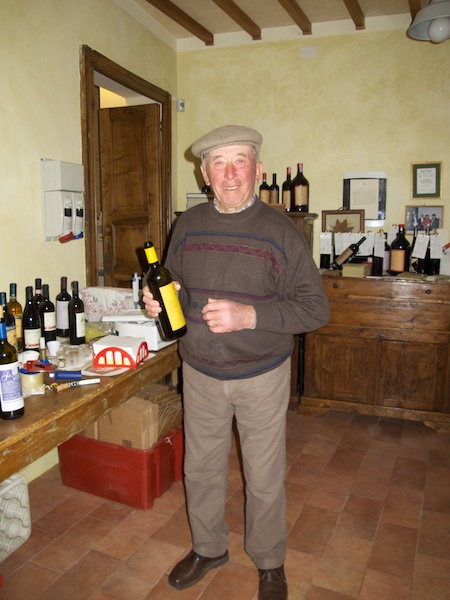 We’ve really outdone ourselves.
We’ve really outdone ourselves.
That we’ve outdone ourselves, a couple that has spent the better part of a decade eating and drinking their way across Italy, whose mission over the past four years has been to become intimate with every chef and restauranteur and winemaker in Umbria, is quite a feat. But for the past day, we have put the dolce in the vita and we drank ‘em bot’ up.
* * *
Our 26.2 hour gluttony marathon began yesterday afternoon, after a tedious but important and long scheduled business meeting in nearby Ponte San Giovanni. There, for hours that seemed like days, we did business Italian-style, which resembles a traditional country dance, with partners executing set pieces, stepping toward one another, then backing up, throwing the hands up and to the side, turning around, circling one another, all designed to keep them from embracing each other and expressing their true feelings. For hours we, too, circled, dodged and dove, everyone knowing the inevitable conclusion of our deliberations, but only breaking through at the last minute. It is Italy at its most ridiculous and its most authentic. It is frustrating yet rewarding. It simply is.
 So we returned to the villa, our brains and psyches exhausted, to collect up the adults in our group for our long planned visit to the Paolo Bea winery in nearby Montefalco. Bea is one of the best known Umbrian winemakers, at least in the American market where he is also the most beloved. In America he has assumed mythic status. We had tried his wines when we first set up camp in Umbria four years ago, and despite its elevated price tag, had fallen in love with it, making a visit to the winery a top priority. It had been nearly four years since our first visit and it was definitely time to return.
So we returned to the villa, our brains and psyches exhausted, to collect up the adults in our group for our long planned visit to the Paolo Bea winery in nearby Montefalco. Bea is one of the best known Umbrian winemakers, at least in the American market where he is also the most beloved. In America he has assumed mythic status. We had tried his wines when we first set up camp in Umbria four years ago, and despite its elevated price tag, had fallen in love with it, making a visit to the winery a top priority. It had been nearly four years since our first visit and it was definitely time to return.
We arrived at Bea’s winery located just  beyond Montefalco in the Cerreto locality. A strada del vino sign announces the vineyard and you enter through narrow gates on a dirt road flanked on one side by what appears to be the Bea residence and on the other by some barns and equipment sheds. Beyond this complex lies the winery, an incredibly impressive travertine stone building with wooden accents, designed by Bea’s architect son. Like so much that is Bea, the building is not so much a series of contradictions as it is a certain duality, with one’s perceptions constantly shifting, like the 3-D postcards that mimic movement when you shift them. Like so much that is Bea, the building itself seems almost alive.
beyond Montefalco in the Cerreto locality. A strada del vino sign announces the vineyard and you enter through narrow gates on a dirt road flanked on one side by what appears to be the Bea residence and on the other by some barns and equipment sheds. Beyond this complex lies the winery, an incredibly impressive travertine stone building with wooden accents, designed by Bea’s architect son. Like so much that is Bea, the building is not so much a series of contradictions as it is a certain duality, with one’s perceptions constantly shifting, like the 3-D postcards that mimic movement when you shift them. Like so much that is Bea, the building itself seems almost alive.
One could spend a day simply enjoying the building itself. From the massive yet light travertine slabs, to the beautiful, airy openings carved on its surface, to the warm contrasts of the wooden accents both exterior and interior, it is a building that is beautiful yet functional. A building that houses wine making machinery and tanks, but connects that wine to the earth rather than alienating and separating it, allowing earth, air and light to penetrate and affect the processes that go on inside.
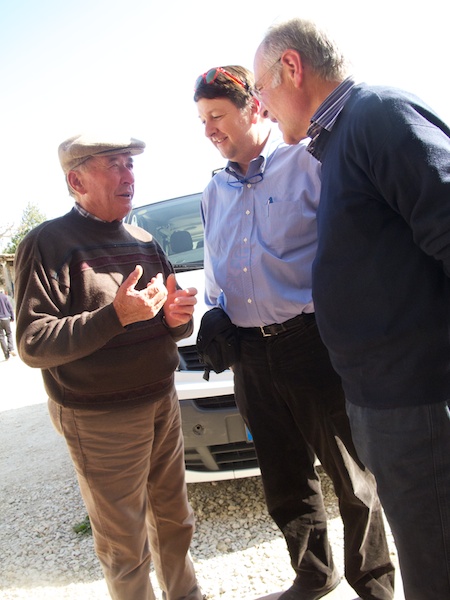 But we were here to learn about and taste the wines of Paolo Bea, not the architecture of his son. So after a brief wait outside the door of the winery we were joined not by our guide Sergio, but a slight older man with thick, leathery hands, dressed in a plaid shirt and gray sweater, rough work pants and a cap. This was Paolo Bea himself, the man, the winemaking legend. Today’s visit would be a memorable one, indeed.
But we were here to learn about and taste the wines of Paolo Bea, not the architecture of his son. So after a brief wait outside the door of the winery we were joined not by our guide Sergio, but a slight older man with thick, leathery hands, dressed in a plaid shirt and gray sweater, rough work pants and a cap. This was Paolo Bea himself, the man, the winemaking legend. Today’s visit would be a memorable one, indeed.
* * *
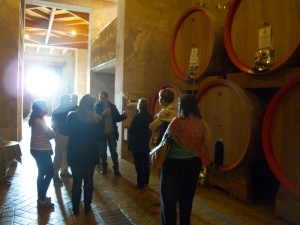 For the next hour our guide Sergio walked us through the winery, showing us where and how Bea makes its wine and occasionally telling us why. For the why is what truly separates Bea’s wine from its competitors. Where others may make wine, Bea’s philosophy is that “wine is not made by man but generated by nature.” According to Bea, “nature should be observed, listened to and integrated, not dominated.” The result is a wine that is not a beverage, but a living creature. We were to be reminded of this later when we convened in the tasting room.
For the next hour our guide Sergio walked us through the winery, showing us where and how Bea makes its wine and occasionally telling us why. For the why is what truly separates Bea’s wine from its competitors. Where others may make wine, Bea’s philosophy is that “wine is not made by man but generated by nature.” According to Bea, “nature should be observed, listened to and integrated, not dominated.” The result is a wine that is not a beverage, but a living creature. We were to be reminded of this later when we convened in the tasting room.
Throughout the visit, Paolo Bea simply was. He did not lecture, interject or dominate. Instead, he could most often be found chatting cordially with our friend Lodovico, the one Italian in our group and himself a man of the land. For the most part, Bea simply followed along, placid and unexpressive, but all the while affecting the outcome of our visit as the moon affects the tides. This is a man who is a rock star in the world of wines, a veritable Mick Jagger and John Lennon wrapped into one, but who seems to see himself as a simple farmer who has committed himself to being a partner with nature rather than a master of the universe.
 During the visit we learned of Bea’s appreciation of and respect for the cycles of nature, the phases of the moon, and, most importantly, getting out of the way of nature. His son’s cantina reflects the father’s philosophy. The massive travertine walls are part of nature yet provide a cool constant temperature inside the building. Channels are designed in the walls to allow for the natural circulation of air from the earth, which is also exposed in the building through other narrow channels. Light from the sun is brought inside through massive windows and light from the moon reaches the basement through a series of glass covered holes punched in floors, designed to align with the lunar path. At other places these features might seem contrivances. Here at Bea they seem natural and ordinary.
During the visit we learned of Bea’s appreciation of and respect for the cycles of nature, the phases of the moon, and, most importantly, getting out of the way of nature. His son’s cantina reflects the father’s philosophy. The massive travertine walls are part of nature yet provide a cool constant temperature inside the building. Channels are designed in the walls to allow for the natural circulation of air from the earth, which is also exposed in the building through other narrow channels. Light from the sun is brought inside through massive windows and light from the moon reaches the basement through a series of glass covered holes punched in floors, designed to align with the lunar path. At other places these features might seem contrivances. Here at Bea they seem natural and ordinary.
* * *
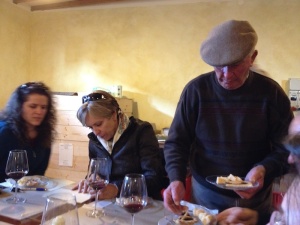 The tasting takes place in the main house and again Paolo Bea has followed along with our group. Inside we are treated to eight of Bea’s wines as Sergio, not the maestro himself pours and describes the wines. Bea simply is, standing nearby, reacting with a barely perceptible smile as we ooh, our eyes light up and we offer our comments. Occasionally he disappears for a few minutes, re-emerging with plates of bruschetta or cheese or the other foods that are provided to accompany our tasting. It’s hard to imagine Robert Mondavi serving plates of cheese to guests at his winetastings.
The tasting takes place in the main house and again Paolo Bea has followed along with our group. Inside we are treated to eight of Bea’s wines as Sergio, not the maestro himself pours and describes the wines. Bea simply is, standing nearby, reacting with a barely perceptible smile as we ooh, our eyes light up and we offer our comments. Occasionally he disappears for a few minutes, re-emerging with plates of bruschetta or cheese or the other foods that are provided to accompany our tasting. It’s hard to imagine Robert Mondavi serving plates of cheese to guests at his winetastings.
 The wines, two whites, five reds and a sweet dessert passito are not so much good or tasty as they are interesting. In fact, in several cases they seem only marginally related to the more traditional offerings of their Umbrian counterparts. Of interest, Bea does not produce a grechetto, the ubiquitous Umbrian white wine that is part of nearly every producer’s portfolio. Bea apparently does not think much of grechetto, producing instead a blend of five white grapes that includes 20% grechetto. But it is not just the blend that differentiates his Santa Chiara I.G.T Umbria, but the winemaking. Unlike traditional whites, Bea ferments the wine on the skins for 20 days or more, the resulting wine taking more of the character of the grape and yielding a cloudy copper colored wine that is complex yet lighthearted at the same time. Eschewing tradition, such as producing grechetto, is not a problem for Bea when he believes the tradition is a commercial contrivance. He prefers to do what he considers the right thing, rather than the traditional thing.
The wines, two whites, five reds and a sweet dessert passito are not so much good or tasty as they are interesting. In fact, in several cases they seem only marginally related to the more traditional offerings of their Umbrian counterparts. Of interest, Bea does not produce a grechetto, the ubiquitous Umbrian white wine that is part of nearly every producer’s portfolio. Bea apparently does not think much of grechetto, producing instead a blend of five white grapes that includes 20% grechetto. But it is not just the blend that differentiates his Santa Chiara I.G.T Umbria, but the winemaking. Unlike traditional whites, Bea ferments the wine on the skins for 20 days or more, the resulting wine taking more of the character of the grape and yielding a cloudy copper colored wine that is complex yet lighthearted at the same time. Eschewing tradition, such as producing grechetto, is not a problem for Bea when he believes the tradition is a commercial contrivance. He prefers to do what he considers the right thing, rather than the traditional thing.
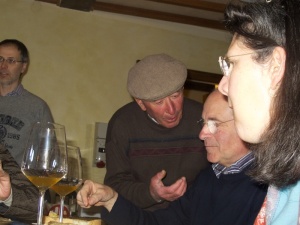
This willingness to buck convention or rather ignore convention runs through the tasting and commentary. An I.G.T. Umbria Rosso, that he calls San Valentino was originally intended to be a Montefalco Rosso D.O.C. but denied the classification by the consortium’s tasting panel. No matter, in subsequent years Bea produced an I.G.T. intentionally, preferring to make the wine he thought tasted right, rather than one that conformed to the tasting panel’s preconceptions. This is a man that has built a certain market position through force of will and is willing to spend his political capital to follow his convictions. A man who may believe and trust more in nature than in people.
We did not particularly like every wine that we tasted that day and perhaps with our limited vocabulary we simply did not understand all of them. But we walked away with an understanding of wine as a living thing, which has embedded within it the diversity of nature and life. The same is true with Bea’s winery. And the same is true of Paolo Bea himself.
* * *
From the sublime to the ridiculous. That describes the transition from wine tasting to dinner.
Dinner at the villa was to be another typical affair. Seating for 18 and food enough for 50.
* * *
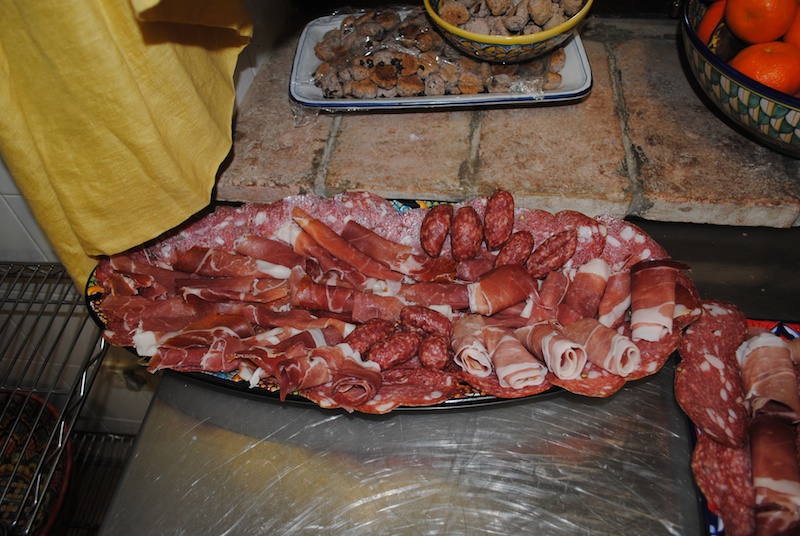 Over the past week our group of guests has grown from six to 13. But dinner was planned to honor our local business partners with whom we had danced earlier that morning, as well as a new friend, Mauro, who manages a supermarket and pork butchery and distributorship in Rome. Mauro, bless his soul, agreed to provide the meat for dinner – pork ribs, sausages, salamis, prosciuttos, veal and cheeses – and we agreed to provide the chef, the sides, the wine and the venue. This is division of labor at its finest.
Over the past week our group of guests has grown from six to 13. But dinner was planned to honor our local business partners with whom we had danced earlier that morning, as well as a new friend, Mauro, who manages a supermarket and pork butchery and distributorship in Rome. Mauro, bless his soul, agreed to provide the meat for dinner – pork ribs, sausages, salamis, prosciuttos, veal and cheeses – and we agreed to provide the chef, the sides, the wine and the venue. This is division of labor at its finest.
Our guests assembled around 8:00 and the feasting began a half hour later. And sometime after 1:00am we pushed our chairs away from the tables having consumed pounds of sausage, grilled meats, cheeses, potatoes, salads and dozens of bottles of wine. Along the way we learned Italian and our Italian friends began to speak English. The contrived dance of that morning gave way to joke telling, laughing and smiling.
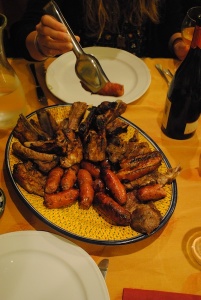
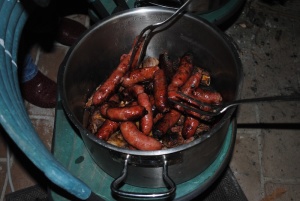
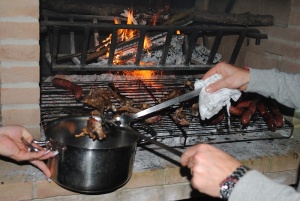
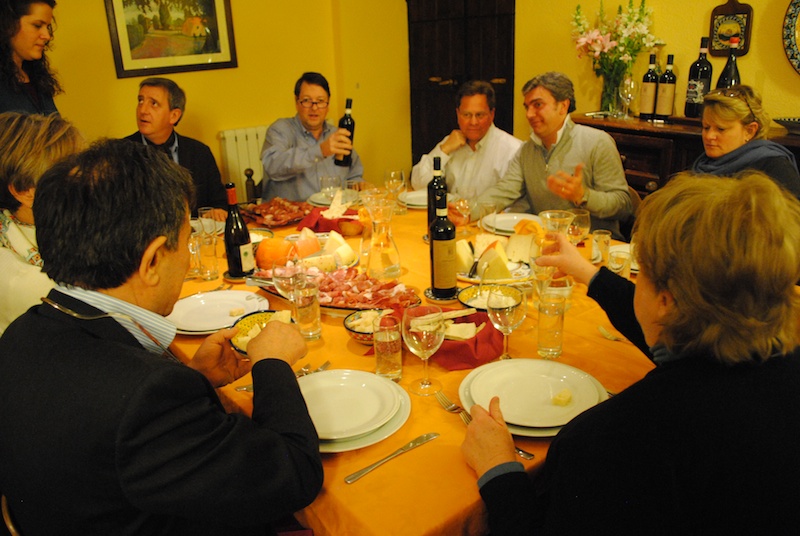 And the center of attention of the meal was the meat. Mauro simply outdid himself, perhaps wanting to show off a little about his expertise. If that was his intention, he succeeded wildly. At one point when discussing sausage, I noted that we had recently tried a special sausage from Fabriano in the neighboring region of Le Marche. Our group had uniformly found it to be fantastic. When told this, Mauro scrunched his nose and looked a little miffed. “Beh,” a typical Italian putdown. “I do not like it so much. My sausage is the best. Senza paragone.” Without equal. Strong words, but backed up in reality.
And the center of attention of the meal was the meat. Mauro simply outdid himself, perhaps wanting to show off a little about his expertise. If that was his intention, he succeeded wildly. At one point when discussing sausage, I noted that we had recently tried a special sausage from Fabriano in the neighboring region of Le Marche. Our group had uniformly found it to be fantastic. When told this, Mauro scrunched his nose and looked a little miffed. “Beh,” a typical Italian putdown. “I do not like it so much. My sausage is the best. Senza paragone.” Without equal. Strong words, but backed up in reality.
Dinner, our meatlover’s meatfest, was truly senza paragone.
* * *
Today’s installment of all you can eat was held at one of our favorite Montefalco restaurants, l’Alchimista. L’Alchimista is one of the area’s best wine shops and also features an outstanding cross section of local artisanal foods. Downstairs, however, it boasts one of the best kitchens in the area, with traditional recipes paired with local wines from their wine list, one of the most extensive in the area. Our group of 14 piled into a ridiculously long table that had been set for us and we began the gorging anew. Two and a half hours later, after numerous antipasti and four pastas we stumbled back into the sunlight, ready for a nap, a stomach pump and a trip to rehab. Ambitious plans that had been laid out for the afternoon were scrapped as afternoon siestas cried out. We had finally reached our limit, a test in just how far you can push the human body.
It was a glorious 26.2 hours. But now it is done. A memory that will live on in our minds and on our hips.
* * *
And if you’ll excuse me, I have to run. Our table at Ernesto’s is waiting for us for dinner.
Ci vediamo!
Bill and Suzy
Visit our Paolo Bea photo gallery!
[slideshow id=10]

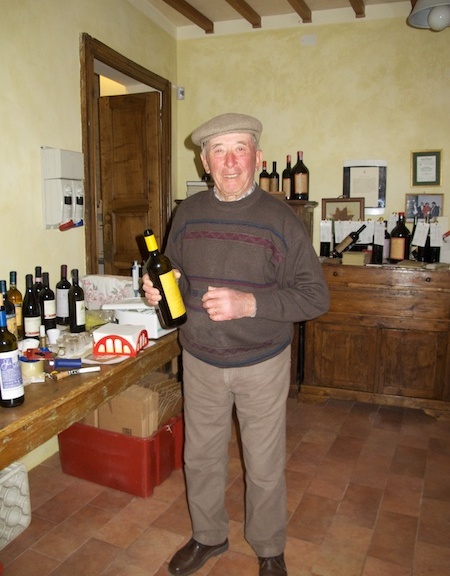
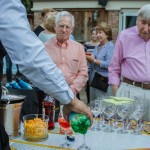
About The Author
Related Posts
Albertino Pardi hosted a special dinner at Casa Menard last weekend, for friends of the…
Having a small dinner/snack at the regional enoteca in the nearby town of Cormons. The…